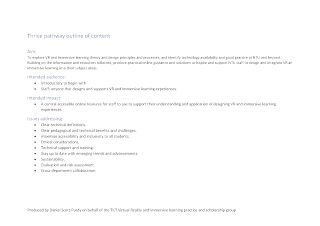Following on from my previous work in VR and immersive learning:
- Virtual Reality wall
- Exploring a pedagogical rationale for VR and immersive learning
- Enabling positive Virtual Reality and immersive learning adoption: a journey of integrating VR walls
- TILT Virtual Reality and Immersive Learning practice and scholarship group
- What is Immersive Learning and VR?
- Teaching Innovation of the Year, Student Nursing Times Awards 2024
- IHAP immersive learning & Virtual Reality design framework
- How to create an online immersive learning experience
To start progress on one of my self-designed 2023/2024 appraisal objectives. Which is to scale up the pedagogical and technical use of our, Institute of Health and Allied Professions (IHAP) VR suites through colleague collaboration by July 2024. Two outputs of which are:
- “Develop a process and guidance to enable academics and clinical skills technicians to engage and work with me on co-designing, ideating and prototyping on immersive learning design
- Exploit intermediate and advanced functionality of our VR walls, and promote and train academics and clinical skills technicians using them, producing appropriate guidance and resources”
Following my previous efforts to integrate and scale up the VR suites during 2022-2023, wider department uptake has not been that successful across many of our courses. Paramedicine lecturers and students remain the most frequent users. This was mainly due to my own staff resource and time to work with nursing and other early adopter paramedicine lecturers, to explore and exploit further potential of the technology. But now that I have a colleague and operate as a small team, I am now able to spend some quality time on this piece. In order to assess the current position and usage, I designed a survey by way of building my capacity to support lecturers and clinical skills technicians to use our VR immersive rooms more effectively. With the view of offering meaningful support and collaborative approaches. The survey questions aim to gather insights into lecturers and technicians technical and practice abilities in using the technology, including wider information on attitudes and blockers helping to identify specific knowledge gaps and areas for improvement. 22 responses were received by 31 January 2024. Below is the Microsoft Forms summary providing an overview of the collective response - no formal report required, this is to obtain the information I need to progress my developments with. As I suspected, it is evident that the following is lacking, in no particular order; curriculum alignment, protected development time, room size, immersive pedagogy and technical know-how (revisit basics, continue training in-person and hands-on, with time to cover basic troubleshooting, finding and selecting appropriate media, continue to conclude with pedagogical conversation). I'm particularly interested in the gap of immersive learning design knowledge and skills in utilising our immersive rooms and facilities. A deeper dive on the outcomes is now required to embed in the planning of my approaches. Some relevant response extracts:
- Farai Pfende, Senior Lecturer in Learning Disabilities Nursing – “Look forward to any CPD to help build confidence, understanding. I am not sure I can ever create this stuff independently but willing to have a go. Protected time is the biggest challenge at the moment but working on it.”
- Gruia Dimcea, Lecturer in Paramedicine Science - “Ongoing best-practice sharing; step-by-step video set-up guides with common FAQ's included and troubleshooting.”
- Anna Price, Clinical Skills Technician – “If the system worked as it should, it would perhaps encourage others to use the VR suite and therefore increase knowledge and confidence.”
- Adam Chillman, Senior Lecturer in Mental Health Nursing – “Thank you for you help using the rooms!”








